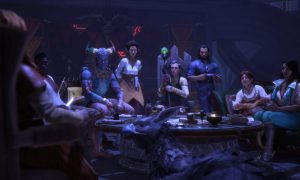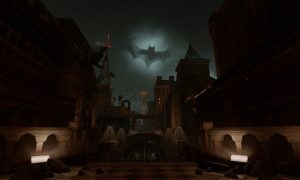Ten years. Ten years ago a scrappy new developer born from questionable circumstances released their debut game. Ten years ago that game immersed us in the era of World War II like no other first-person shooter before it and raised the bar of the genre to new heights. Ten years ago we were raising the Banner of Victory on the Reichstag in Berlin.
Since then the series has exhausted the genre of WWII shooters, moved on to hyper-realistic modern military combat, and even dipped into the near future with ever more fantastic plots and weaponry. The Infinity Ward of today certainly isn’t the Infinity Ward of ten years ago, though the franchise’s blockbuster status hasn’t wavered due to the loss of its founding leaders to more mech-filled horizons. Shedding the blockbuster brand of Modern Warfare is as much about a fresh start for the studio as it is a bold new direction as the new console generation begins.
 Much like last year’s Black Ops II, the main timeframe for Ghosts’ campaign lies in the near future. Also like Black Ops II, your enemies rise up from South America, though without a comic book villain like Raul Menendez leading the charge. The main conceit of the plot revolves around an event that causes a sudden shift of power that leaves the US fighting against a “newly emerged, technologically-superior global power.” I’ll be honest, the beginning is rather good; after a brief campfire tale introducing the legend of the Ghost Squad, the narrative puts you in the (moon) boots of a soldier floating above the orbiting space station as the fateful event happens. Once you get back down to Earth, it’s ten years later in the role of son Logan, patrolling the devastated badlands of the Los Angeles metropolitan area with your brother Hesh (Brandon Routh) and faithful hound Riley (whose presence is somewhat muted considering how much they enthused about the dog during E3). Naturally, Logan – your character – doesn’t talk, and while this works for some games, it actually seems very forced here, especially with the familial connections that are a central part of what’s going on. Routh’s Hesh has to do a lot of heavy lifting as a result, engaging in enough emoting for the both of you.
Much like last year’s Black Ops II, the main timeframe for Ghosts’ campaign lies in the near future. Also like Black Ops II, your enemies rise up from South America, though without a comic book villain like Raul Menendez leading the charge. The main conceit of the plot revolves around an event that causes a sudden shift of power that leaves the US fighting against a “newly emerged, technologically-superior global power.” I’ll be honest, the beginning is rather good; after a brief campfire tale introducing the legend of the Ghost Squad, the narrative puts you in the (moon) boots of a soldier floating above the orbiting space station as the fateful event happens. Once you get back down to Earth, it’s ten years later in the role of son Logan, patrolling the devastated badlands of the Los Angeles metropolitan area with your brother Hesh (Brandon Routh) and faithful hound Riley (whose presence is somewhat muted considering how much they enthused about the dog during E3). Naturally, Logan – your character – doesn’t talk, and while this works for some games, it actually seems very forced here, especially with the familial connections that are a central part of what’s going on. Routh’s Hesh has to do a lot of heavy lifting as a result, engaging in enough emoting for the both of you.
Collared Duty

For all the talk about the dog earlier this year, it feels as if Infinity Ward felt a little stung by the criticism and pulled back on Riley a bit. The times he does appear in the campaign feel a little contrived and more like controlling a drone, and he barely appears after the halfway point. I suppose we should be thankful that we didn’t get the anticipated ‘Old Yeller’ moment, but somewhat startling is the fact that they included the dog as a killstreak bonus in multiplayer. Expect some backlash to the shooting of dogs, as well as dog-on-dog battles that occur during play.
In the beginning, Logan and Hesh aren’t yet Ghosts, just regular soldiers under the command of their father, Captain Elias Walker. It isn’t long before the titular squad appears, leading to a reveal that surprises no one and the subsequent joining of the Ghosts by the Walker boys. From here the plot gets extremely uneven, alternating between thrilling set pieces and dull, derivative schlock. One scene in particular is ripped whole from the movie Dark Knight Rises; there’s no mistaking it, and I audibly groaned when I realized it. Also, apparently, Ghosts are that in more than just name, as a couple of characters are capable of taking several bullets at point blank range with barely a flinch.
 It IS worth sticking it out through the mid-game lull, however, as things definitely take a turn for the better in the third act and the game ends on a strong note. In fact, the uneven plot doesn’t really distract much from some excellent level design and set pieces throughout- what’s a little eye-rolling as long as it’s good shooty fun, right? The underwater and space levels in particular are ridiculously fun, even if it makes no sense that firing an assault rifle in zero gravity doesn’t send you hurtling backwards with every recoil — even Moonraker had the sense to use lasers. There were several moments during the better parts of the game where the vibe was not unlike a James Bond movie, which had me wondering aloud what Infinity Ward could do with the franchise if given the chance.
It IS worth sticking it out through the mid-game lull, however, as things definitely take a turn for the better in the third act and the game ends on a strong note. In fact, the uneven plot doesn’t really distract much from some excellent level design and set pieces throughout- what’s a little eye-rolling as long as it’s good shooty fun, right? The underwater and space levels in particular are ridiculously fun, even if it makes no sense that firing an assault rifle in zero gravity doesn’t send you hurtling backwards with every recoil — even Moonraker had the sense to use lasers. There were several moments during the better parts of the game where the vibe was not unlike a James Bond movie, which had me wondering aloud what Infinity Ward could do with the franchise if given the chance.
The Next-Gen difference

Having spent extensive time with both the PS4 and PS3 versions of the game (as well as the Xbox One and 360 versions), the differences between current-gen and next-gen lie more in the visual details than anything else; faces are softer and feel more human than they ever have, environmental effects are more detailed and realistic, and the space scenes are exponentially more stunning on the PS4. There were a few occasions where I experienced frame-rate issues, but the added lushness made for a much more cinematic experience.
All that aside, the real draw to the Call of Duty games is the multiplayer, and while Ghosts doesn’t radically change the formula too much, the tweaks and new additions are very polished. Changes made to player customization are notable as much by what they took away as what they added. ‘Create-A-Class’ has become ‘Create-A-Soldier,’ allowing you to customize your character beyond just loadouts: heads, body types, even gender. It was nice hearing some female voices on the battlefield, finally. The new perks system jettisons the complexity of tiers and limiting the number of perks per tier, instead setting point values between one and five on each perk. Perks are divided into Speed, Handling, Stealth, Awareness, and Resistance, and you can equip up to eight points worth of perks — eleven if you forego secondary weapon and equipment choices. Every aspect of your loadout is governed by budget similar to Black Ops II’s ‘Pick 10’ point allocation system, and as usual the key to unlocking various weapons, attachments, perks, and equipment is gaining XP in multiplayer and earning tokens. There are roughly thirty new weapons, including a new Marksman Rifle class, which fit somewhere in between Sniper Rifles and Assault Rifles. The Honey Badger Assault Rifle became a quick favorite due to the built-in silencer. You can build up to ten soldiers in this way, each with a unique appearance, set of perks, and loadout, and each one can attain a level of prestige.
 Returning multiplayer game modes include the tried-and-true (Team Deathmatch, Free-for-All), additions made in recent installments of the series (Infected, Kill Confirmed) and three new modes to keep things fresh: Search and Rescue, Cranked, and Blitz. Search and Rescue underscores the theme of cooperative team play by combining the team-oriented Kill Confirmed mode and the objective-based Search and Destroy mode, allowing team members to revive rather than just giving you a single life per round. Cranked is based on Team Deathmatch, but kills grant you new abilities as long as you stave off the countdown clock that ticks away before you kill again. If you’re familiar with the Jason Statham movie series of the same name you’ll get the general idea.
Returning multiplayer game modes include the tried-and-true (Team Deathmatch, Free-for-All), additions made in recent installments of the series (Infected, Kill Confirmed) and three new modes to keep things fresh: Search and Rescue, Cranked, and Blitz. Search and Rescue underscores the theme of cooperative team play by combining the team-oriented Kill Confirmed mode and the objective-based Search and Destroy mode, allowing team members to revive rather than just giving you a single life per round. Cranked is based on Team Deathmatch, but kills grant you new abilities as long as you stave off the countdown clock that ticks away before you kill again. If you’re familiar with the Jason Statham movie series of the same name you’ll get the general idea.
Field Orders are a totally new wildcard element thrown into the mix- the first kill of a match drops a briefcase that when picked up, sets a random requirement that once fulfilled yields a care package drop and refills on ammo and equipment. If you are killed before you fulfill your Field Order, a new briefcase is dropped for someone else to pick up and get a random new requirement of their own. I found it to be a nice little addition that helps balance out some of the killstreak craziness that can sometimes be found in matches. Maps on the whole seem larger this time around, with a general visual and structural emphasis on rubble, likely to tie in with the catastrophic events of the campaign more effectively. There was mention of dynamic events that change the face of certain maps, but I didn’t see any happen during my time with the game.
New moves

Getting around in the game has never been easier thanks to a few new moves that really add some fluidity to your character. The new mantling system enables you to move quickly over objects and from rooftop to rooftop, sometimes while still firing your weapon. The new contextual lean system gives you more options while under cover without having to learn new controls. My favorite by far, though, is the knee slide, allowing you to slide from a full sprint to prone without losing the ability to shoot at your enemy.
The newest addition to multiplayer this year could almost stand alone as a separate game: Squads. In Squads you build up a team of soldiers that each have their own rank-up system and customization. Those ten soldiers that you can create, rank up and customize? They are your squad members, and in this type of play, you not only choose which member you control but also the rest of your team. Squad-mates on your team can be AI-controlled, and utilize real-life techniques like jump-shooting, corner-camping and side-strafing. During a round of Squad vs. Squad, which is a two-player match that pits your squad against theirs, my opponent equipped all of his teammates with C4 launchers; every time I managed to reach a capture point I’d get hit from all directions by time-delayed explosives. He didn’t even realize how effective the strategy was until I showed him how impossible it was to escape from the certain fiery death his bots were raining down on me. Friends, either online or local, can also jump in at any time as members of your squad for some quick co-op play. Of the other three modes, by far the most intriguing is Squad Assault, which allows you to attack another friend’s squad, who can determine the map they defend and the loadouts of their team. Wargame is a larger-scale battle that is similar to Squad vs. Squad with the addition of the ability to swap out your team members on the fly, and Safeguard is a four-player co-op that harkens back to the Firefight mode of Halo ODST — defend against waves of enemies while weapons and equipment periodically drop and you rank up your abilities and expertise along the way. Based on what I saw, the AI for the bots in Squads was exceptional, and this was definitely the highlight of my multiplayer experience.
 I have mixed feelings about the final multiplayer game mode — Extinction is Infinity Ward’s answer to Treyarch’s Zombies mode, though unlike Zombies it has a tenuous connection to the main game (The catastrophic event of the campaign brought with it an alien menace of space dogs that shoot acid from their tails. It’s… a stretch.) In this four-player co-op mode, you and your team face wave after wave of aliens that spawn every time you attack a pod group. It isn’t just about survival, as you can level up equipment and proficiencies, aid and rearm your team with your class abilities, and ultimately purge the town of the alien space dogs. I found Extinction to be more fun than Zombies, but my main gripe is that there is only one map for the mode. Considering the wealth of riches found elsewhere on the game disk, that seems almost petty, but it feels like there could be more, and likely will be a big part of upcoming DLC.
I have mixed feelings about the final multiplayer game mode — Extinction is Infinity Ward’s answer to Treyarch’s Zombies mode, though unlike Zombies it has a tenuous connection to the main game (The catastrophic event of the campaign brought with it an alien menace of space dogs that shoot acid from their tails. It’s… a stretch.) In this four-player co-op mode, you and your team face wave after wave of aliens that spawn every time you attack a pod group. It isn’t just about survival, as you can level up equipment and proficiencies, aid and rearm your team with your class abilities, and ultimately purge the town of the alien space dogs. I found Extinction to be more fun than Zombies, but my main gripe is that there is only one map for the mode. Considering the wealth of riches found elsewhere on the game disk, that seems almost petty, but it feels like there could be more, and likely will be a big part of upcoming DLC.
The second screen

There has been some considerable dabbling in augmenting game experiences with complementary mobile or tablet apps in recent years, but the new Call of Duty app looks to bring your game to a whole new level. I didn’t get to spend much time with it on my own, and plan to give the app my full attention once it launches alongside the game this week, but I did get a chance to talk with John Lindon the studio head of app developers Beachhead:
Expect a full review of the app soon.
Author’s note: This review is based on time spent with the game on a PS4 provided at a review event held by Activision. Travel expenses were provided by Activision to attend the event.
Mike Dunn is the old man of Gaming Trend, having cut his teeth on Atari consoles and First Edition Advanced Dungeons & Dragons back in the day. His involvement with Gaming Trend dates back to 2003, and he’s done everything from design and code to writing and managing. Now he has come full circle, with a rekindled passion for tabletop gaming and a recent debut as Dungeon Master (nearly forty years after he purchased the original DMG).

Ghosts doesn't leverage the PS4 beyond providing a more visually immersive experience, it stands as a more than capable bridge for the franchise. While the campaign is relatively short at eight hours and at times feels very derivative, the high points really shine and the multiplayer experience continues to set the bar for the genre.
PROS
- Set pieces in space and underwater are ridiculous fun.
- Multiplayer player customization is deeper yet more accessible.
- Squads brings a great new multiplayer mode to the franchise.
CONS
- Campaign drags significantly in the middle with some incredibly trite plot twists.
- Dogs attacking dogs in multiplayer feels wrong.
- Extinction mode could benefit from additional maps.
See below for our list of partners and affiliates:

























